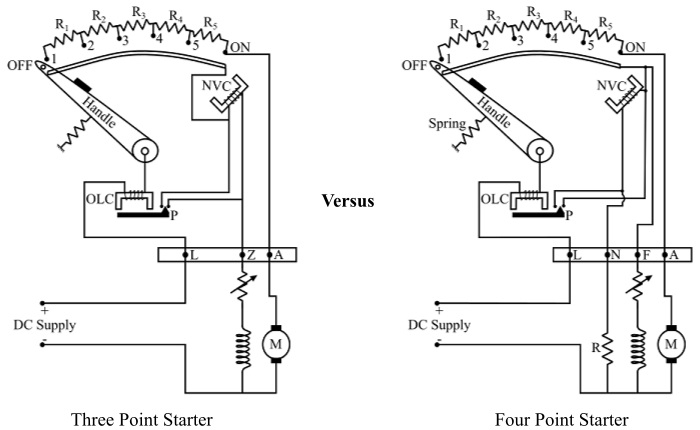
 Data Structure
Data Structure Networking
Networking RDBMS
RDBMS Operating System
Operating System Java
Java MS Excel
MS Excel iOS
iOS HTML
HTML CSS
CSS Android
Android Python
Python C Programming
C Programming C++
C++ C#
C# MongoDB
MongoDB MySQL
MySQL Javascript
Javascript PHP
PHP
- Selected Reading
- UPSC IAS Exams Notes
- Developer's Best Practices
- Questions and Answers
- Effective Resume Writing
- HR Interview Questions
- Computer Glossary
- Who is Who
Difference between Three Point Starter and Four Point Starter
An electric circuit that is used to start an electric motor is called a starter. Depending on the type of electric motor, there are different types of starters available.
In this article, we will discuss the basics of three-point starters and four-point starters which are used for DC motor starting. We will also highlight how these two types of starters are different from each other.

What is a Three Point Starter?
As its name implies, a three point starter (shown in the above figure) is the one which has only three points (or terminals). A typical three point starter has a tapped resistance to limit the starting current in a permissible range. There are three terminals namely line terminal (L), field terminal (Z) and armature terminal (A).
The three terminals L, Z and A of the starter are connected to the positive terminal, the shunt field terminal and the armature terminal respectively. The other ends of the armature and the shunt field windings are directly connected to the negative terminal of the supply.
The no-volt trip coil (NVC) is connected in shunt field circuit, which provides protection against the open circuit in the field winding. The NVC is also known as under-voltage protection of the motor. One end of the handle is connected to the terminal L through the overload trip coil (OLC) and the other end of the handle moves against the force of control spring and makes contact with each stud during the starting period of operation. The starting resistance is cutting out gradually as the handle passes over each stud in clockwise direction.
What is a Four Point Starter?
A four point starter (shown in the above figure) consists of a graded starting resistance to limit the starting current and is connected in series with the armature of the motor. The tapping points of the starting resistance are taken out to a number of studs. It is called 4-point starter because it has 4 terminals viz. L, N, F and A.
The one end of the armature coil is connected to the terminal A and of the shunt field winding to the terminal F. The other ends of the armature and the shunt field windings are directly connected to the negative terminal of the supply.
The no-volt trip coil (NVC) is connected directly across the line with a current limiting resistor R in series. The NVC is also known as under-voltage protection of the motor. One end of the handle is connected to the terminal L through the overload trip coil (OLC) and the other end of the handle moves against the force of control spring and makes contact with each stud during the starting period of operation. The starting resistance is cutting out gradually as the handle passes over each stud in clockwise direction.
Therefore, with this arrangement, a change in the field current for the variation of the speed of the motor does not affect the current through the NVC, as the two circuits are independent of each other.
Difference between Three-Point Starter and Four-Point Starter
The following table highlights all the significant differences between the three-point starter and four-point starter ?
| Basis of Difference | Three Point Starter | Four Point Starter |
|---|---|---|
| Description | The DC motor starter which has three terminal is called three point starter. | The DC motor starter having 4 terminals is called a four point starter. |
| Terminals | The three terminal of a 3-point starter are line terminal (L), armature terminal (A) and field terminal (Z). | The terminals of a four-point starter are line terminal (L), field terminal (F), armature terminal (A) and an extra terminal (N). |
| Connection between NVC and field | In 3-point starter, the NVC (No Volt Trip Coil) is connected in series with the field coil. | In 4-point starter, the NVC is connected in parallel with the field coil. |
| Suitability | The three point starter is suitable for starting the shunt and compound DC motors. | The four point starter is suitable for starting such DC motors that has variable speed. |
Conclusion
The most significant difference that you should note here is that, in a three-point starter, the no volt coil is connected in series with the field coil, while in a four-point starter, the no-volt coil is connected in parallel with the field coil.

